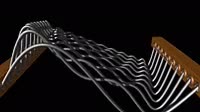Animation showing the conductivity of lead bromide, an ionic compound. Initially the solid salt is poured into a bowl, and electrodes connected to a light bulb are placed in it. No current flows through the solid. The salt is then heated until it melts, and the current does flow through the liquid salt, and the bulb lights up. This effect is caused by the mobility of the ions. Ionic compounds are made up of positive and negative ions (of lead and bromine respectively here), bonded together as their electric charges attract each other. In the solid, the force of this attraction means that the ions are not able to move, and no current flows. When molten, the heat energy breaks these bonds, (inset), liberating the ions and allowing a flow of current between the electrodes. Brown bromine is seen bubbling up from the anode (positive electrode) here. Electrolysis of molten salts is preferable over electrolysis of their solutions when, as in this case, the solubility and the melting point are both low. See clip K004/3401 for a similar demonstration with sodium chloride, which has a higher melting point and solubility.
Details
WebID:
C01808477
Clip Type:
RM
Super High Res Size:
1920X1080
Duration:
00:00:30.000
Format:
QuickTime
Bit Rate:
25 fps
Available:
download
Comp:
200X112 (0.00 M)
Model Release:
NO
Property Release
No













 Loading
Loading